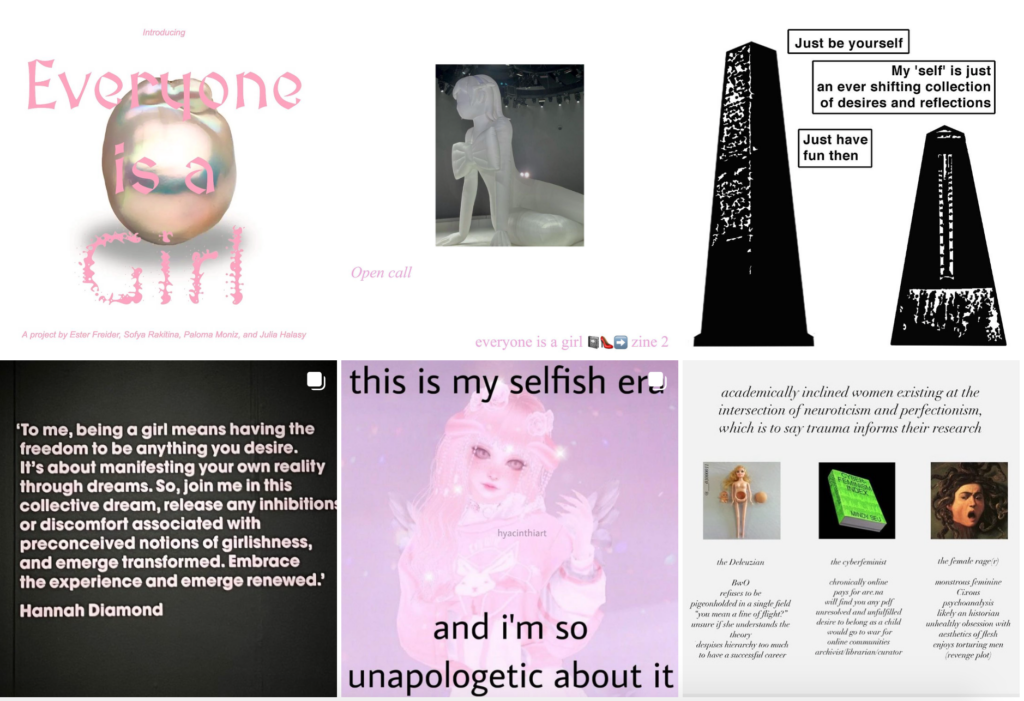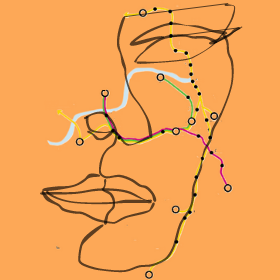By Marisse Cato

In the darkness of the Internet it seems girl’s do just want to have fun. Playing dress up, melding their supposed “self” more and more deeply with an internet self, submitting to the politics of performance and surveillance culture. For you pages of hysteric Baroque damsels captioned “she’s just like me fr” and pale pink Barbie text posts have prompted a critical engagement with girl culture online through girl culture online.
Titularly and conceptually inspired by Alex Quicho’s article “everyone is a girl online”, the project founded by Ester Freider, Sofya Rakitina, Paloma Moniz and Julia Halasy, explore the experience of being online as that of a feminine subject whereby one ‘tactically submits’ to the digital algorithm and plays in performances of self through both visibility and privacy.

Their launch event featured mini-presentations from contributors on various themes, responding to the prompts 𝒶𝓁𝒾𝑒𝓃𝒶𝓉𝒾𝑜𝓃, 𝓂𝒶𝓃𝒾𝓅𝓊𝓁𝒶𝓉𝒾𝑜𝓃, 𝓅𝑒𝓇𝒻𝑜𝓇𝓂𝒶𝓃𝒸𝑒, 𝓈𝓊𝒷𝓂𝒾𝓈𝓈𝒾𝑜𝓃, 𝒻𝑒𝓂𝒾𝓃𝒾𝓃𝒾𝓉𝓎, 𝒾𝓁𝓁𝓊𝓈𝒾𝑜𝓃, 𝓅𝓁𝒶𝓎, 𝑒𝓍𝒸𝑒𝓈𝓈, 𝑔𝓁𝒶𝓂𝑜𝓊𝓇. Some more academic in delivery, based in philosophy, others more performative or immersive. The audience of girls online – mainly 18-25 year old white middle-class or European international students – joined together for an event which successfully extended the pearls, bunnies, and Sylvanian family projections of girlhood online into the real world at Pushkin House. The evening enjoyed a welcoming buzz and excitement with presented topics peaking personal, academic and artistic interests across the room of both personal friend of the founders as well as a sizeable representation of their previously solely online community.
Key ideas they invite engagement with include:
“the female is any psychic operation in which the self is sacrificed to make room for the desires of another.” – Chu 2018
“the girl is an inhuman category. Relegated through patriarchy creating a closer affinity between woman and technology and the artificial.” – Bogna Konior 2020
“the girl as a consumer category, never delinked from capital.” – Tiqqun 1999
Presentations engaged the prompts liberally, exploring topics that extended into gender and sexuality studies, live poetry recitation with accompanying graphics and painting performance art. This multidisciplinary engagement only pointed to the wealth of angles and behaviours and processes to explore at this critical reader’s intersection of online identity, and femininity. Explored through popular culture references, girl-adjacent symbology and metonyms, arguably the memorabilia intersectional feminisms seek to evade being reductively construed as– that is being co-opted, and repurposed in crafted and chosen online presentations.
Elida Silvey’s closing Baby Bird video was a particularly memorable contribution. The old cartoon of a baby bird interspersed with popular culture icons of the desired and pursued feminine subject – Disney’s animated Cinderella, Sylvester and Tweety bird, decadent Baroque period drama women, pink satin pumps, Naomi Campbell from the “In the Closet” Michael Jackson music video. These images intertwined with the original Baby Bird story, subject to the perils of their animated woodland environment ravaged by fire and subject to the will of the forces around them, paralleled with these media performances of girls online is woven together by its voiceover exploring the manipulation of the online feminine images “we” consume and love, telling the baby Bird’s story, revealing the limits and extensions of its agency.
In terms of creating a dialogue and a forum for exploring in critical and creative ways this cyberbaroque phenomena, the girlies have done it. The floor invited interesting and interested responses following each presentation and their zine’s second edition is accepting submissions. As the platform grows, for those who don’t see themselves as participating in “girl culture online”, whose explore pages aren’t flooded with pink-hued text posts, bows, and ballet-core, how do you respond to and engage in the assertion the assertion “everyone is a girl online”?
Follow their work @everyoneisagirl on Instagram and on their website https://everyoneisagirl.cargo.site

Leave a Reply